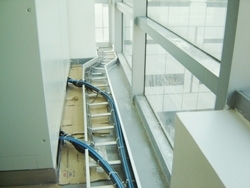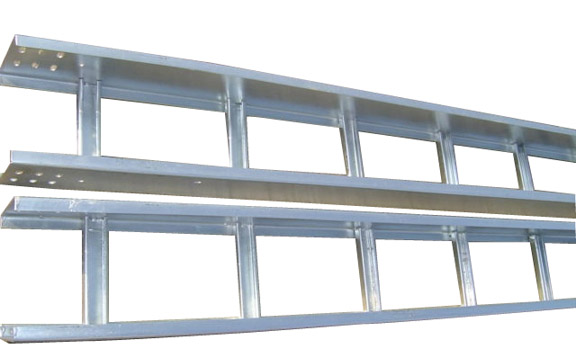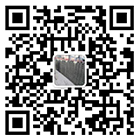電纜槽盒安裝技術(shù)特點(diǎn)
(1)彈線(xiàn)定位
(1) Snap line positioning
根據設計圖確定出進(jìn)戶(hù)線(xiàn)、盒、箱、柜等電氣器具的安裝位置從始端終端(先干線(xiàn)后支線(xiàn))找好水平或垂直線(xiàn)用粉線(xiàn)袋沿墻壁、頂棚和地面等處在線(xiàn)路的線(xiàn)進(jìn)行彈線(xiàn)按照設計圖要求及施工驗收規范規定分勻檔距并用筆標出具體位置如果支吊架固定位置有與頂板預應力肋梁沖突處應避開(kāi)肋梁位置。
According to the design drawing, determine the installation position of electrical appliances such as incoming lines, boxes, boxes, and cabinets from the beginning to the end (starting with the main line and then the branch line). Find horizontal or vertical lines and use a chalk bag to snap the lines along the centerline of the wall, ceiling, and ground. Divide the span according to the design drawing requirements and construction acceptance specifications, and mark the specific position with a pen. If there is a conflict between the fixed position of the support and hanger and the prestressed rib beam of the top plate, avoid the rib beam position.
橋架安裝技術(shù)交底 施工要點(diǎn)
Key points for technical disclosure of bridge installation construction
(2)支吊架安裝
(2) Installation of supports and hangers
在確定支吊架的位置時(shí)應符合設計規定當設計無(wú)明確規定時(shí)也可按生產(chǎn)廠(chǎng)家提供的產(chǎn)品特性數據確定。
When determining the position of the support and hanger, it should comply with the design regulations. If there are no clear regulations in the design, it can also be determined based on the product characteristic data provided by the manufacturer.
電纜橋架水平敷設時(shí)支撐跨距一般為1.5~2m。
When the cable tray is horizontally laid, the support span is generally 1.5~2m.
電纜橋架垂直敷設時(shí)固定點(diǎn)間距不宜大于2m。
When laying cable trays vertically, the spacing between fixed points should not exceed 2m.
支架與吊架在安裝時(shí)應掛線(xiàn)或彈線(xiàn)找直用水平尺找平以保證安裝后橫平豎直。
During the installation of brackets and hangers, lines should be hung or snapped for alignment, and a horizontal ruler should be used to ensure horizontal and vertical alignment after installation.
非直線(xiàn)段的支、吊架位置見(jiàn)圖1橋架彎通或三通、四通彎曲半徑不大于300mm時(shí)
The positions of supports and hangers for non linear sections are shown in Figure 1. When the bending radius of the bridge bend, tee, or cross is not greater than 300mm
應在距彎曲段與直線(xiàn)段接合處300~600mm的直線(xiàn)段側設置一個(gè)支吊架。當彎曲半徑大于300mm時(shí)還應在彎通中部增設一個(gè)支、吊架。
A support and hanger should be installed on the side of the straight section at a distance of 300-600mm from the junction of the curved section and the straight section. When the bending radius is greater than 300mm, a support and hanger should also be added in the middle of the bend.
橋架安裝技術(shù)交底 施工要點(diǎn)


Key points for technical disclosure of bridge installation construction
橋架吊架安裝
Bridge hanger installation
當電纜橋架水平懸吊安裝時(shí)一般使用雙圓鋼吊架和角鋼、槽鋼吊架安裝.圓鋼吊桿的角鋼、槽鋼的規格長(cháng)度.視工程設計或實(shí)際需要選用。
When the cable tray is horizontally suspended and installed, double round steel hangers and angle steel and channel steel hangers are generally used for installation. The length of the angle steel and channel steel specifications of the round steel hanger rod depends on the engineering design or actual needs.
橋架安裝技術(shù)交底 施工要點(diǎn)
Key points for technical disclosure of bridge installation construction
電纜橋架支、吊架調整
Adjustment of cable tray supports and hangers
電纜橋架安裝中對橋架的支、吊架位置誤差應嚴格控制。電纜橋架支、吊架應安裝牢固橫平豎直。托臂及支、吊架的同層橫檔應在同一水平面上其高低偏差不應大于5mm.防止縱向偏差過(guò)大使安裝后的托盤(pán)、梯架在支、吊點(diǎn)懸空而不能與支、吊架或托臂直接接觸;橋架支、吊架或托臂沿橋架走向左右偏差不應大于10mm.支、吊架或托臂的橫向偏差過(guò)大可能會(huì )使相鄰托盤(pán)、梯架錯位而無(wú)法連接或安裝后的電纜橋架不直而影響美觀(guān)。
During the installation of cable trays, the position error of supports and hangers should be strictly controlled. Cable tray supports and hangers should be installed firmly, horizontally and vertically. The horizontal bars of the same layer of the support arm and support and hanger should be on the same horizontal plane, and their height deviation should not exceed 5mm. To prevent excessive longitudinal deviation, the installed tray and ladder should be suspended at the support and hanger points and cannot directly contact the support, hanger or support arm; The deviation of the bridge support, hanger, or bracket along the direction of the bridge should not exceed 10mm. Excessive lateral deviation of the support, hanger, or bracket may cause adjacent trays or ladders to be misaligned and unable to be connected, or the installed cable tray may not be straight and affect aesthetics.









